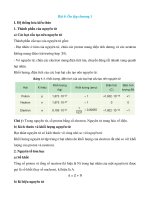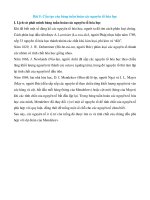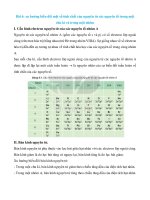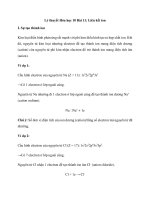KỸ NĂNG ĐỘNG VIÊN TRONG QUẢN LÝ GS, TS, BS LÊ HOÀNG NINH
Bạn đang xem bản rút gọn của tài liệu. Xem và tải ngay bản đầy đủ của tài liệu tại đây (239.5 KB, 30 trang )
KỸ NĂNG ĐỘNG VIÊN
TRONG QUẢN LÝ
GS, TS, BS LÊ HOÀNG NINH
MỤC TIÊU
• Chẩn đốn vấn đề năng lực làm việc
• Thúc đẩy khả năng người khác trong cơng việc
• Tạo được môi trường thúc đẩy / động viên
trong công việc
CÔNG THỨC NĂNG LỰC
Formula for Performance
Performance = Ability x Motivation (Effort)
Ability = Aptitude x Training x Resources
Motivation = Desire x Commitment
Diagnosing Poor Performance
• How difficult are the tasks?
• How capable is the individual?
• How hard is individual trying to succeed at the
job?
• How much improvement is individual making?
Ba dấu hiệu nguy hiểm của suy giảm khả năng
(Three Danger Signals of Ability Degeneration)
1. Taking refuge in a specialty
2. Focusing on past performance
3. Exaggerating aspects of the leadership role
Năm công cụ giúp cải thiện khả năng
(five tools for improving ability)
1.
2.
3.
4.
5.
Tái cung cấp (Resupply )
Đào tạo lại (Retrain )
Trang bị mới / tân trang ( Refit )
Phân công lại (Reassign)
Trả tự do (Release )
Management Styles
Theory X: Employees are seen as lazy
Theory Y: Employees want to do a good job
Sự liên quan giữa hài lòng và năng lực
Relationship Between Satisfaction and Performance
EMPHASIS ON
PERFORMANCE
EMPHASIS ON
SATISFACTION
LOW
© 2007 by Prentice Hall
HIGH
LOW
HIGH
Indulging
Integrating
Ignoring
Imposing
6-
9
Bốn dạng
1. Buông thả (Indulging): focuses on
satisfaction rather than performance
2. Ấn định (Imposing): focuses on
performance rather than satisfaction
3. Sao lãng (Ignoring ): focuses on
performance or satisfaction
4. Hợp nhất (Integrating): focuses equally on
performance and satisfaction
© 2007 by Prentice Hall
6-
10
Old View of Motivation
Satisfaction → Motivation →
Performance
(Contented Cows give more Milk)
© 2007 by Prentice Hall
6-
11
New View of Motivation
Motivation
Performance
Outcomes
Satisfaction
© 2007 by Prentice Hall
6-
12
Motivation → Performance
Motivation begins with establishing
moderately difficult goals that are
understood and accepted.
© 2007 by Prentice Hall
6-
13
Goal Setting
ã Characteristics of good goals:
â 2007 by Prentice Hall
Specific
Consistent
Appropriately challenging
Provide feedback
6-
14
Motivation → Performance
After setting goals, managers should
remove obstacles to performance.
© 2007 by Prentice Hall
6-
15
Path Goal Theory
Insert figure 6.2
© 2007 by Prentice Hall
6-
16
Performance → Outcomes
Using rewards and discipline to
encourage good exceptional
behavior and extinguish
unacceptable behavior.
© 2007 by Prentice Hall
6-
17
The Best Award Programs
• Give awards publicly
• Use awards infrequently
• Embed them in a reward process
• Acknowledge past recipients in
awards presentations
ã Match award with culture
â 2007 by Prentice Hall
6-
18
Managers’ Actions as Reinforcers
Manager’s get what they reinforce,
not what they want.
© 2007 by Prentice Hall
6-
19
Behavior Shaping Strategies
© 2007 by Prentice Hall
6-
20
Disciplining: responding negatively to
behavior to discourage future
occurrences.
Rewarding: linking desired behaviors
with employee-valued outcomes.
© 2007 by Prentice Hall
6-
21
Extrinsic Outcomes: outside the
control of the individual.
Intrinsic Outcomes: experienced by
the individual as a result of
successful performance.
© 2007 by Prentice Hall
6-
22
Work Design
The process of matching job
characteristics and worker’s skill and
interests.
© 2007 by Prentice Hall
6-
23
Job Characteristics Model
Insert figure 6.4
© 2007 by Prentice Hall
6-
24
Work Design Strategies
• Combine tasks
• Form identifiable work units
• Establish client relationships
ã Increase authority
ã Feedback
â 2007 by Prentice Hall
6-
25









